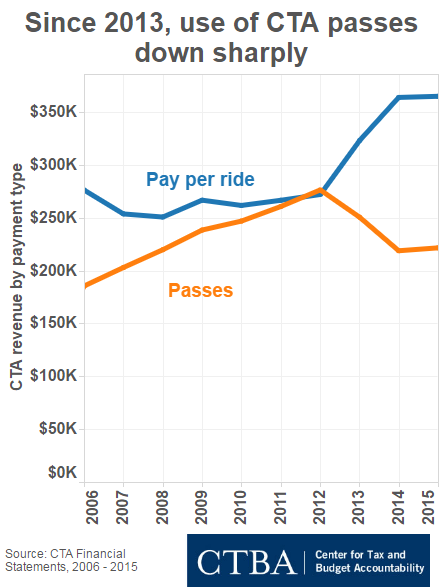Previously on the blog, I’ve written about the short-term decline in bus ridership (couched in medium-term stagnation and long-term catastrophic decline) in the context of drastically reduced service, a theme I also picked up at City Observatory.


But, as Chicago finally reaches the long-anticipated Great Inversion of Transit Ridership—that is, in July 2016, L ridership finally surpassed CTA bus ridership for the first time in the city’s history—I’ve found another possible culprit at CTBA’s Budget Blog.
You should click through to read the whole piece, but the summary is this: CTA financial documents show that from the mid-2000s through 2012, transit passes—fare products that give you unlimited rides for one, three, seven, or 30 days—had been growing as a share of all rides, and single-ride tickets had been falling. During this entire period, minus the big economic crash and service cutbacks of 2009 and 2010, ridership growth across the system, even on buses, was pretty robust.

Then suddenly in 2013, the use of passes absolutely nosedives, and continues to crash in 2014, before leveling out in 2015. These years also represent the first sustained decline in CTA ridership outside of a recession since 2000.

My theory is this: In 2013, two things happened that caused people to move from passes to single-ride tickets. First, at the beginning of the year, the CTA massively increased the price of passes across the board, without raising the price of a single ride. Second, later in the year, the CTA began its transition to Ventra, which replaced disposable passes with the (confusing to many people) permanent Ventra card, which could store passes bought at fare machines or in other locations around the city.
My guess is that both of these things are behind the move away from passes. Significantly, the decline continues into 2014, when Ventra fully replaced the old system, before stabilizing in 2015, suggesting that the early 2013 price increases aren’t the whole story.
So what does this have to do with ridership? Well, buying a pass makes your marginal cost for a CTA trip free. That means you’re much more likely to take a trip that you might not if your marginal cost is $2 or $2.25. Studies of transportation behavior bear out that even seemingly small changes in the marginal cost of a trip can have meaningful impacts on choices.
And why would this affect buses more than the L? I can think of at least two good reasons. The first is that navigating the new Ventra system is easiest when you have a fare machine in front of you, plus a CTA employee (who isn’t currently operating a vehicle) nearby to help—something L riders have every time they go to a station, but bus riders don’t. Second, bus riders, on average, have significantly lower incomes than L riders, and so would be more sensitive to the pass price increases of 2013.
Does this explain everything? Definitely not. Is it all speculative? Pretty much. Is the change in pass use extremely dramatic, and would we expect it to have some kind of impact on ridership? Yes, and probably.